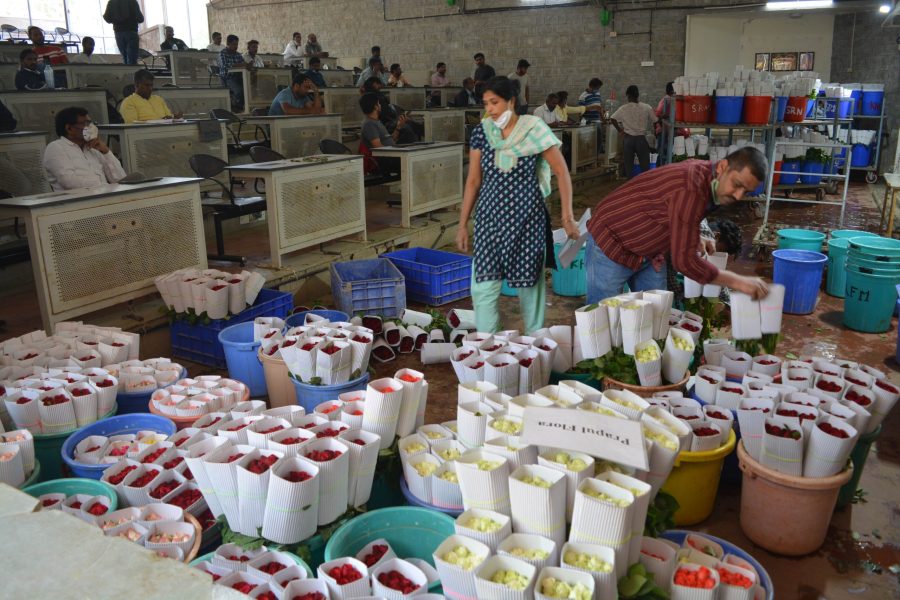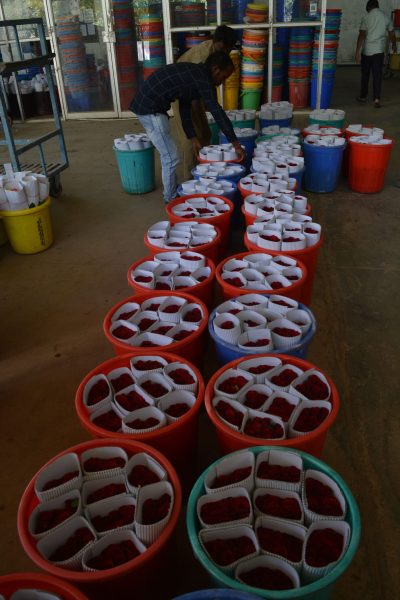
After two hard years, business looks rosy again for flower industry

In the front-yard of International Flower Auction Bangalore Ltd (IFAB), pick-up vehicles are unloading their cargo of roses that have just arrived from farms outside the city. Inside, at the auditorium, bidders are snapping up lots every few seconds – on average, more than 5 lakh roses are sold every day at IFAB this Valentine’s Week leading up to February 14. After two hard years when demand for flowers slumped because of the pandemic, things are looking rosy again for roses.
Bangalore is the biggest hub for the rose trade in India and growers from the region say that both demand and prices are looking up this season. “The surprising thing is we have got the highest number of export orders this year,” says M Sridhar, managing director of Suvarna Florex, which has farms in Hosur just beyond the Karnataka border. “I can say it is a good Valentine’s.”
Add to that the local wedding season, which has picked up in the last couple of weeks as Omicron restrictions eased up across the country. “The market is very good. There will be weddings up to June-end,” says Srikanth Bollapally, a director at the grower’s body, South India Floriculture Association (SIFA). “The domestic market is wedding-based. When the wedding season is strong, then the prices are good.”
That wasn’t the case six months ago. Even up to October, growers say the prospects were looking dim, forcing many to quit the business and turn to other crops. The floriculture trade has been badly hit since the pandemic set in and events came to a grinding halt – while exports fell, the local wedding season between April and June was a washout in both 2020 and 2021.

“It was extremely bad. We have thrown lakhs of flowers,” says Sridhar. “Ninety per cent of the industry was struggling and everyone was thinking whether to continue or not.”
The market for fresh cut roses comprises Dutch roses, which are used for decorations – longer stems fetch better prices. Typically, the time period from a cutting to a new flower is 45 days. When the market was down, growers resorted to pinching the flower – without cutting the stems – so that the plants grow leaves and thereby delaying the next flowering, or they did not replant old bushes.
“A lot of growers quit the business also,” says Bollapally. Things began improving since Diwali as local demand went up and the Omicron wave didn’t also cause much disruption, he says. “Now, after seeing this consistency, people are replanting and some percentage [of growers] are coming back into the business.” Domestic prices are around ₹15-25 a stem, he says.
“It’s only because of the Indian market that today the floriculture industry is surviving,” says Sridhar, whose firm exports nearly 80 per cent of its produce.
Fewer Flights, High Freight Rates
The export market, however, is still impacted by fewer flights and high freight charges. “This year, we got early orders because of the limited flights. Everyone was scared about whether they would get the flowers or not. Generally, they would be discussing up to the last week of January,” says Sridhar. “Limited flights and high air freight is really a very big problem. It’s the biggest challenge and even we are scared to confirm orders from buyers.”
Currently, air freight charges are almost double, he says. To some destinations, like New Zealand for instance, as much as three times. But orders are still coming in since air connectivity is a problem affecting most rose-exporting countries and customers are unable to get enough flowers, says Sridhar.
The top destinations for India’s cut rose exports include the UK, Malaysia, New Zealand, Singapore and Australia.
T M Aravind, a director at SIFA, says growers have requested the government to step in and help the industry. “Because the cargo rates have increased by 30-40 per cent, exporters are not coming forward,” he says. “Now the production is good and market consumption is also good. But growers who were affected during 2020 and 2021 will require another two years to recover that loss.”
Fresh cut roses accounted for 5 per cent of India’s total floriculture exports of ₹575.98 crore in 2020-21. The floriculture export industry includes cut flowers, pot plants, cut foilage, seeds bulbs, tubers, rooted cuttings and dried flowers or leaves.
The major centres for floriculture include Maharashtra, Karnataka, Andhra Pradesh, Haryana, Tamil Nadu, Rajasthan and West Bengal.
Bangalore’s Rose Connection
For roses, the region around Bangalore ticks all the boxes for conducive growing conditions – elevation, temperature and soil – besides connectivity. Sridhar of Suvarna Florex reckons that this region accounts for almost 50 per cent of India’s production of Dutch roses.
Bangalore produces a minimum of 3 million stems a day, supplying to international destinations as well as Indian metros, says Srikanth Bollapally. Domestically, Delhi and Hyderabad are the biggest consumers of roses from here.
Some portion of that is sold through the IFAB – a joint venture between the Karnataka government and growers – where auctions are held every day. Currently, about 50-60 growers sell their produce through IFAB.
“The demand for roses has increased this year, even the production is good,” says IFAB managing director Dr M Viswanath. “Last year, we received an average of 4 lakh flowers per day during the Valentine’s season. But now we are receiving on an average 5 to 5.5 lakh.”
In fact, IFAB is eyeing a turnover of ₹50 crore this financial year, higher than its previous best of ₹35 crore in 2018-19.
Currently, the average prices at IFAB are ₹12-₹14 per stem. Typically, quality is determined by three parameters – length of the stem, size of the bud and leaf quality. “Anything more than 50 cm (stem size) fetches a very good price,” says Viswanath.
For flower growers, the hope is that the current trend holds out. Volumes haven’t recovered to the level they used to be at earlier, points out Bollapally. “Once the number of flights increases, I think the exports will continue at the volumes that were happening before.”

